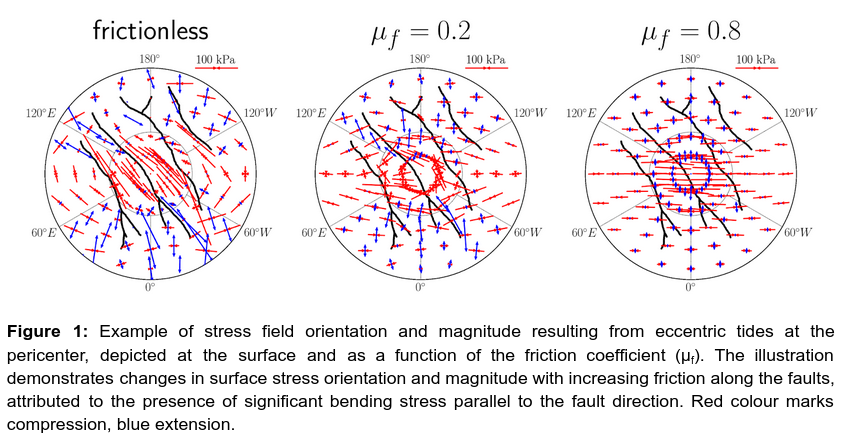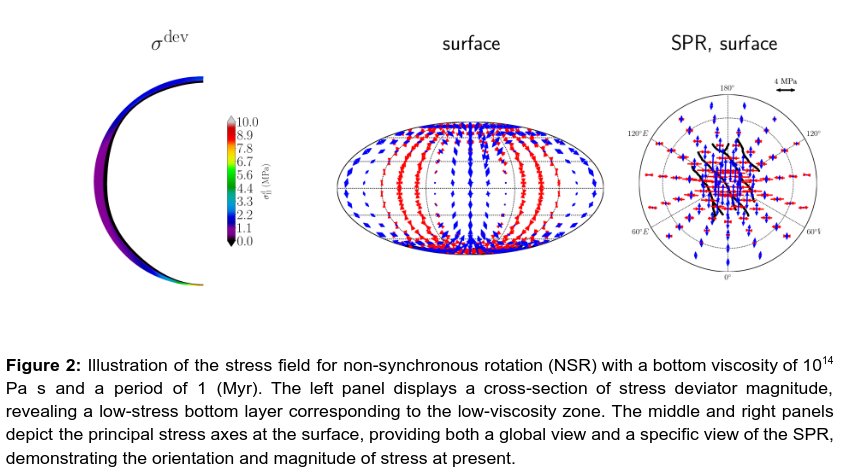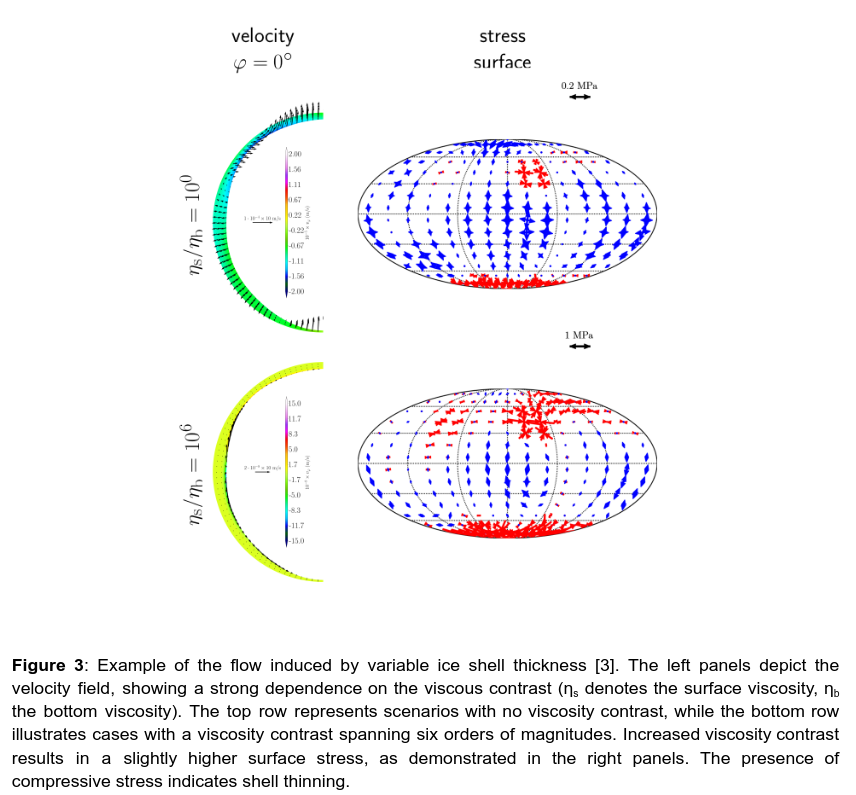Deformation of Enceladus’ Ice Shell: From Tidal Forces to Viscous Flow
- 1Charles University, Faculty of Mathematics and Physics, Department of Geophysics, Prague 2, Czechia (marie.behounkova@mff.cuni.cz)
- 2Mathematical Institute, Faculty of Mathematics and Physics, Charles University, Prague, Czech Republic
- 3Laboratoire de Planetologie et Geosciences, Nantes, France
Introduction
Enceladus exhibits several remarkable characteristics, including a unique cryovolcanic activity [1] accompanied by anomalous heat flux [2], large ice shell thickness variations [e.g., 3], and a complex geological history recorded on the surface [4]. These features result from a complex interplay of internal and external forces operating over various temporal scales. Here, our main objective is to provide a comprehensive synthesis of various processes affecting the stress state of the ice shell from tidal to geological time scales. We study the individual contributions and assess their relative importance. We focus on the eccentricity-driven diurnal stresses enhanced by frictional faults [5-6] and the effect of viscoelasticity. On longer time scales, we assess the impact of non-synchronous rotation [7]. We also investigate the possible role of the long-term viscous flow [3] driven by gravitational instabilities due to the variable ice shell thickness.
Model set-up
To achieve the objectives, we model the elastic or viscoelastic response of the ice shell with variable ice shell thickness with frictional faults to eccentricity tides and non-synchronous rotation. On long-time scales, we investigate the viscous flow resulting from the ice shell thickness variations [3]. In all cases, we employ FE method [8] in order to include the 3D character of the ice shell thickness variations and the presence of faults.
Eccentricity tides
To assess the stress associated with eccentricity tides, we account for variations in ice shell thickness and the presence of frictional faults. Considering the short time scale of 1.37 days and assuming a conductive temperature profile, we model the ice shell's rheology as elastic. The mechanical properties of the fault zone are approximated using a Mohr-Coulomb-type yield criterion [5]. During one orbital period, stress reaches up to 100 kPa in the vicinity of faults and for a low friction coefficient (Fig. 1). The stress regime changes from compressional to extensional and vice versa with depth mainly in the direction parallel to the faults due to the bending stresses. Due to nonlinear friction law, the response is coupled over various periods, effectively contributing to stresses on other time scales. In particular, the friction leads to the emergence of a background static stress in the model. The amplitude of the background stress increases with the friction coefficient and can become comparable to the diurnal component for high friction coefficients.

Non-synchronous rotation
The stress associated with possible non-synchronous rotation (NSR) of Enceladus is examined, taking into account variations in the ice shell thickness. This analysis considers a time scale ranging from 0.01 to 1 million years (Myr) for the period of NSR, as indicated by Patthoff et al. [7]. In our study, we adopt a viscoelastic (Maxwell) rheology, where the viscosity follows an Arrhenius dependence on temperature. A conductive temperature profile is assumed to characterize the thermal dependence of the ice rheology. Our simulations predict that the stress induced by NSR can reach approximately 4 MPa, dominating in stress magnitude among the investigated mechanisms. Furthermore, due to viscoelastic relaxation on NSR periods, a low-stress layer develops near the bottom boundary in the region of decreased viscosity (Fig. 2). However, this layer's impact on surface stress is found to be limited across all studied cases (bottom viscosity ≥1014 Pas). These findings highlight the importance of considering non-synchronous rotation, if present, and its associated viscoelastic effects when evaluating stress dynamics in Enceladus' icy shell.

Viscous flow
We quantify the flow and stress triggered by gravitational instabilities arising from uneven ice shell thickness [3]. On a geological time scale, we model the ice shell as a viscous fluid using the Boussinesq approximation while also incorporating the gravitational signal from the boundaries. We observe significant changes in the flow characteristics, transitioning from radial high-velocity flow (low viscosity contrast) to low-velocity tangential flow concentrated within a thin layer of low viscosity (high viscosity contrast). The maximum surface stress associated with the viscous flow is approximately 0.5 MPa (Fig. 3). Our results also emphasize the dependence of surface stress on the local ice shell thickness, with compressive stress associated with locally thin ice shells.

Summary
Our findings suggest that non-synchronous rotation induces the most significant stress, up to approximately 4 MPa, while surface stress from viscous flow reaches around 0.5 MPa, with compressive regimes in areas of the thinnest ice shell. Eccentricity tides induce comparatively lower stress, peaking at around 100 kPa in the South Polar Terrain. Frictional faults contribute to background stress, influenced by rheological properties, with viscoelastic effects proving negligible. This comprehensive assessment sheds light on the complex dynamics shaping Enceladus' icy surface.
Acknowledgements
This study received funding from the Czech Science Foundation under project number 22-20388S. The computations were conducted at the IT4Innovations National Supercomputing Center (e-INFRA CZ, ID:90254).
References
[1] Porco et al. (2006). Science 311, pp. 1393–1401. doi:10.1126/science.1123013
[2] Spencer et al. (2018) Enceladus and the Icy Moons of Saturn, pp. 163–174. doi:10.2458/azu_uapress_9780816537075-ch008
[3] Čadek et al. (2019). Icarus 319, pp. 476–484. doi:10.1016/j.icarus.2018.10.003
[4] Crow-Willard and Pappalardo (2015) JGR-Planets 120, pp. 928–950. doi:10.1002/2015JE004818
[5] Pleiner Sládková et al. (2021), GRL 48, e2021GL094849. doi:10.1029/2021GL094849
[6] Berne et al. (2023). JGR-Planets 128.6, 2022JE007712. doi:10.1029/2022JE007712
[7] Patthoff et al. (2019). Icarus 321, pp. 445–457. doi:10.1016/j.icarus.2018.11.028
[8] Alnaes et al. (2015). Archive of Numerical Software 3.100, pp. 9–23. doi:10.11588/ans.2015.100.20553
How to cite: Behounkova, M., Soucek, O., Choblet, G., Tobie, G., and Kihoulou, M.: Deformation of Enceladus’ Ice Shell: From Tidal Forces to Viscous Flow, Europlanet Science Congress 2024, Berlin, Germany, 8–13 Sep 2024, EPSC2024-102, https://doi.org/10.5194/epsc2024-102, 2024.